Case Analysis: Management of Depression, Anxiety, and Insomnia

1. Patient Background
Demographics: 32-year-old female, employed as a marketing manager.
Presenting Complaints: Persistent low mood, excessive worry, difficulty falling/staying asleep for 3 months.
Triggers: High work pressure, recent divorce, and financial stress.
Medical History: No chronic illnesses; no prior psychiatric diagnoses.
2. Clinical Presentation
Depressive Symptoms
Persistent sadness, loss of interest in hobbies.
Fatigue, difficulty concentrating.
Feelings of guilt and worthlessness.
Anxiety Symptoms
Excessive worry about job performance and finances.
Restlessness, muscle tension, irritability.
Panic attacks (2 episodes in the past month).
Insomnia Symptoms
Difficulty falling asleep (>1 hour to initiate sleep).
Frequent nighttime awakenings.
Non-restorative sleep, daytime drowsiness.
3. Diagnostic Evaluation
Clinical Interview: Confirmed DSM-5 criteria for Major Depressive Disorder (MDD) and Generalized Anxiety Disorder (GAD).
Sleep Assessment: Insomnia severity index (ISI) score: 18 (moderate clinical insomnia).
Screening Tools:
PHQ-9 (Depression): Score 16 (moderate-severe).
GAD-7 (Anxiety): Score 14 (moderate).
4. Intervention Strategies
A. Psychotherapy
Cognitive Behavioral Therapy (CBT):
Depression/Anxiety: Weekly sessions targeting negative thought patterns, behavioral activation, and stress management.
Insomnia-Specific CBT (CBT-I): Sleep restriction, stimulus control, and cognitive restructuring for sleep-related anxiety.
B. Pharmacotherapy
Antidepressant: Sertraline (SSRI) initiated at 50 mg/day, titrated to 100 mg/day after 2 weeks.
Short-Term Anxiolytic: Lorazepam 0.5 mg PRN (limited to 2 weeks to avoid dependency).
Sleep Aid: Trazodone 25 mg at bedtime (low-dose for sleep initiation).
C. Lifestyle and Behavioral Modifications
Sleep Hygiene: Regular sleep schedule, avoidance of screens before bed, caffeine reduction.
Relaxation Techniques: Daily mindfulness meditation and progressive muscle relaxation.
Social Support: Referral to a support group for divorcees; family counseling sessions.
5. Outcomes
Week 4:
PHQ-9 score reduced to 10 (mild depression).
GAD-7 score reduced to 8 (mild anxiety).
ISI score: 12 (subthreshold insomnia).
Week 12:
Sustained mood improvement; return to work full-time.
Panic attacks resolved; sleep latency reduced to 20–30 minutes.
Medications tapered (lorazepam discontinued; sertraline maintained).
6. Discussion
Key Success Factors
Integrated Approach: Addressing comorbid depression, anxiety, and insomnia concurrently improved overall outcomes.
CBT-I Efficacy: Demonstrated superiority over pharmacotherapy alone for long-term insomnia management.
Early Intervention: Prevented progression to severe MDD or chronic insomnia.
Challenges
Initial non-adherence to sleep restriction due to work demands.
Mild gastrointestinal side effects from sertraline (managed with dose adjustment).
Recommendations
Regular follow-ups to monitor relapse risk.
Gradual tapering of trazodone after 6 months of stable sleep.
Continued mindfulness practice to build resilience against stressors.
7. Conclusion
This case highlights the importance of a multimodal treatment plan for patients with overlapping depression, anxiety, and insomnia. Combining psychotherapy, judicious pharmacotherapy, and lifestyle adjustments led to significant symptom remission and functional recovery. Tailoring interventions to individual stressors (e.g., divorce, work pressure) was critical to achieving sustainable outcomes.





